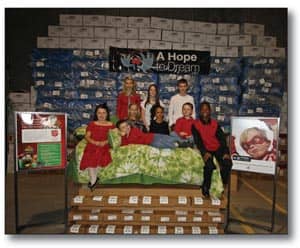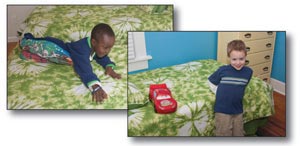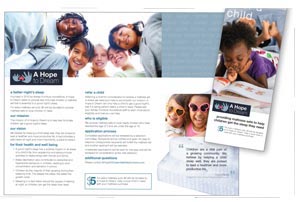Editor’s note: The following interview with Kendra Maggert, Interactive Marketing Manager, Ashley HomeStores, Ltd., is the first in a series focusing on charitable initiatives in the home furnishings industry. The object of these articles is to provide models for those in our industry who have an interest in supporting existing programs, or in launching meaningful charitable initiatives of their own.
Question: What is the purpose of the "A Hope to Dream" program?
Answer: A Hope to Dream’s mission is to help less fortunate children get a good night’s sleep by providing them with a mattress set (twin Ashley Sleep memory foam mattress, foundation/ frame & comforter set).
Question: What reasons did Ashley Furniture HomeStores have for focusing on children as the program’s beneficiaries?
Answer: We wanted to continue our efforts in making a difference in communities where we operate, and at the same time, create a charitable effort that Ashley Furniture HomeStores could call its own.
Since children are a vital part of any growing community, we looked for a way to help them to live healthier and more productive lives. We know that a good night's sleep has a positive impact on all areas of a child's life, from academics and extracurricular activities to relationships with friends and family.
 |
A Hope to Dream (Jacksonville, FL) partners with Salvation Army to provide 50 beds to children in need this past holiday season (left).
|
Question: Did one individual in the organization champion the initiative?
Answer: Ben Thorud, our Sr. VP, Ashley HomeStores, Ltd., was the driving force to get the program started. He asked if I would be interested in leading the program and be responsible for developing the SOPs, logistics, assets, launch process, etc. I was honored! Since then, we have had so many other employees join in making the program a success. Without their help and passion, the program wouldn't be where it is today. It truly is a group effort.
Question: What considerations should Furniture World readers who are thinking about starting their own program be mindful of?
Answer: First, you need to ensure you are starting a program for the right reasons - what is your intention? Is it genuine? If so, you're on your way to success. Then you begin to prepare by making sure that launch documents, assets, roll out checklists and training materials are all in place. If your intention was truly genuine this is where you will see the program come to life. Your staff will become engaged and want to spread the word about the goodwill that they, and their company, are a part of.
Question: What steps did you take to make sure the program would roll out smoothly?
Answer: We began by first developing program details and assets at a corporate level and rolling out the program in 52 of our corporately owned Ashley Furniture HomeStores. We wanted to make sure, that as designed, the A Hope to Dream program would address the local need and guarantee that our store staff would embrace the program. It did! After 6 months, we had given away almost 900 beds in our 52 corporate Ashley Furniture HomeStore locations.
Then we invited our Ashley Furniture HomeStore licensees to join us in their own local markets. Today, we have over 170 independently owned and operated Ashley Furniture HomeStore locations supporting the A Hope to Dream program (visit www.ahopetodream.com to see a full list of participating locations).
We have also found it beneficial to assign one or more “Local Market Champions” in each market. These people are responsible for coordinating a smooth and effective roll-out, including making connections with local schools, churches, and other community organizations. It works best if the official person in charge has a passion for the program and a willingness to educate others – knowing that others will follow once they get involved and create their own personal connection.
However, it’s important for any organization to remember that when starting a program like this, that the responsibility of the program’s operation should not rest solely with just one person.
 |
Photos taken on mattress deliveries.
|
Question: Did the organization learn any valuable lessons?
Answer: We learned that programs like this won’t run on their own. Effort has to be applied continuously to keep them alive.
We found that it is very important to make contacts in the local community and keep them abreast of program efforts and updates. Without the involvement of these community partners, who act as ambassadors, it would not be possible to have a viable program. After all, the A Hope to Dream program needs these contacts to refer children in need of a mattress set.
Seeking out community members and establishing trusting relationships is time consuming, but is essential to our program.
Question: How has working on A Hope to Dream influenced you personally?
Answer: Watching the program grow has been an indescribable experience. Going on deliveries, meeting the families and seeing the smiles on kids faces is what drives me! Personally, it has opened my eyes and made me realize how easy I had it growing up.
We knew there was a need and that many children don’t get the sleep they desperately need, but to be honest, I think many of us were shocked at the level of need that exists in our own backyards.

|
Pictured is a brochure that explains the program and helps to generate leads to find children in need.
|
Question: Did you need to do any special corporate or tax planning?
Answer: A Hope to Dream is not a registered charity. We looked into this, but we came across some limitations with our licensee structure. We really wanted our program to live at a local level – allowing our stores to collect funds and distribute them in their own local communities.
The accrual accounts are set up at the store/market level. At the end of each month our licensees look at how many mattresses they sold and multiply by the donation amount. It’s as easy as that!
However, we do have customers ask if they can make cash donations to the program. Since we are not a registered charity, we cannot provide them with a tax deduction form, but some customers are okay with that too.
Question: What can retailers do to ensure that charitable initiatives don’t become a secondary priority?
Answer: I believe that it is very important for retailers to manage the intention of their charitable programs. At the end of the day, an effort such as this does take time and resources. However, the full team including marketing, customer service, sales, finance, delivery, etc. should be reminded of the program's core intention. In our case, it's to help children and make a difference in our local communities.
This is another reason why getting staff involved in the program is critical. We invite our staff to call recipients and go along on deliveries. This allows them to make a personal connection, and tell their own stories about what the A Hope to Dream program means to them. We know if we provide the opportunity for our staff to DO, they will UNDERSTAND. They will naturally want to move the program forward, knowing that they help to make a difference in their communities.
Question: Is it important to set goals for any charitable effort?
Answer: Yes, we set goals on the number of mattress sets we hope to give away, and we're always looking to increase store participation. In our first year alone we gave away almost 2,000 beds. For 2012, our goal is to double that!
Question: Do companies need to be careful not to seem to exploit recipients or congratulate themselves too much?
Answer: Yes, I think there is a fine line to be walked. It becomes a problem if an organization’s charitable intention is NOT true, factual and genuine. Store staff, customers and the local community will see through it. After all, reading from a script comes across like pretending to care, so anyone in a retail organization who needs to memorize his or her lines will come across as not genuine, and that will reflect negatively on the entire effort.
That’s why I take the time to share personal stories about deliveries and try to get across the simple fact that something most of us have always taken for granted, a bed to sleep in, is not a reality for a number of children. I only encourage stores to become part of the A Hope to Dream program if they have a true desire to make a difference and help these children.
Question: Based on what you see in our industry, what final advice can you leave with Furniture World readers?
Answer: Get employees involved! These programs should be a feel good for all, and something many employees have the ability to touch and help out with. If your staff is not involved, the program will lack life and energy. Allowing retail staff to have a personal connection to the program will allow their true passion to shine through and make the program what it is, or intended to be, heartfelt and real.
Charitable Program Points For Furniture Retailers To Consider
- Ensure your intention is true, factual and genuine.
- Get employees involved – let them bring the program to life. What they DO, they will UNDERSTAND.
- Create contacts that count at schools, churches and local organizations – they will become ambassadors for your program.
- Be careful using your program for its PR and sales-building potential. It's “ADDED VALUE” and should not drive your program initiatives.
- Remember to manage the program based on your original intention – to give back and make a difference!
Russell Bienenstock is Editor-in-Chief of Furniture World Magazine, founded 1870. Comments can be directed to him at editor@furninfo.com.